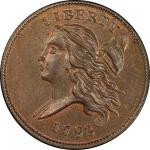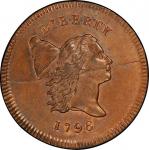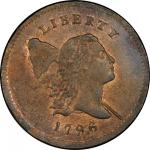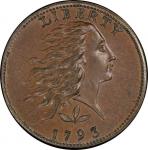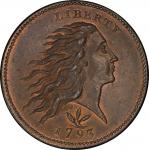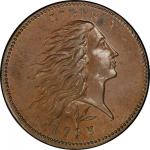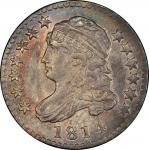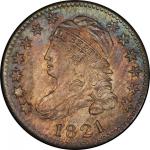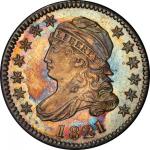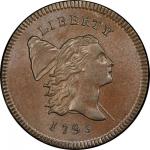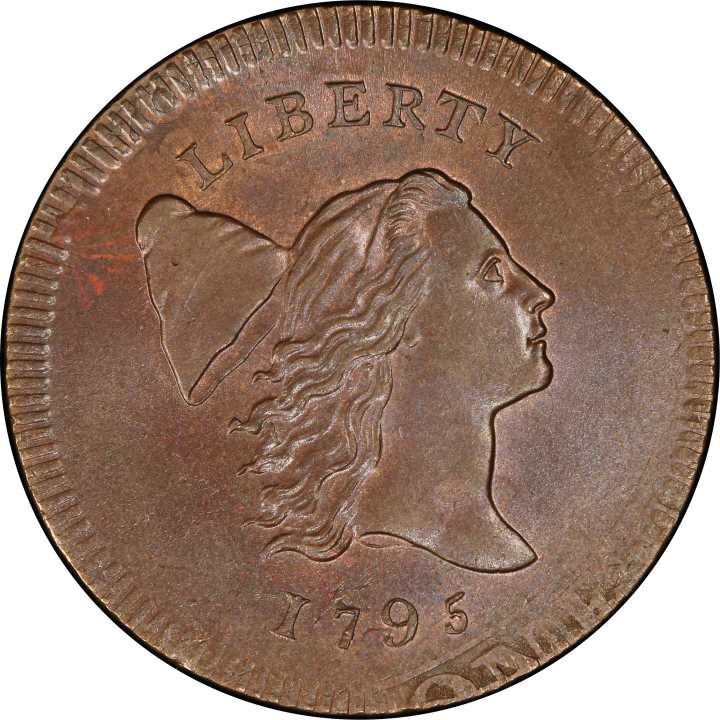“April 23. Talbot, Allum & Lee, 1,076 lbs. of copper @ 18¢. $193.68.” — Chief Coiner’s Account Book, 1795 A dichotomy in copper, this gem is a treasure struck atop a piece of trash, a discarded token that became a cherished half cent. Resounding cartwheel luster enlivens the traces of mint color that persist around LIBERTY, atop Liberty’s head, in front of her profile, and around the date. Most of the surfaces have toned a magnificent frosty ruddy brown, retaining traces of pale blue and gold, the reverse blending its faded mint color into a uniquely beautiful, even brown tone. Neither obverse nor reverse has received even a single significant contact mark. A small gathering of tiny ticks is seen above 7 of the date, while the reverse shows a similar batch above the last A of AMERICA and a single mark above L of HALF. A tiny clod of detritus adheres to the lower interior of R in AMERICA, where it has undoubtedly rested for generations. The undertype or host, a 1794 or 1795 Talbot, Allum & Lee one cent token, is chiefly visible on the obverse, though a hint of legends from the obverse of the undertype is visible at the outside of the reverse denticles near 2:00. On the obverse of the half cent, YORK is intact and visible in the denticles above LIB of LIBERTY. To its left, the flag from the mainmast of the vessel on the token is clearly outlined. At the base of the obverse, a good deal of ONE of the token’s denomination may be seen, and some hints of rigging are outlined in deep red between the lowest curl and the top of the date numerals. Such abundant traces of undertype are not unusual for specimens of this variety; in fact, the vast majority of 1795 Cohen-6 half cents (and 1795 No Pole half cents in general) are struck over cut-down Talbot, Allum and Lee cents acquired by the U.S. Mint for the price of raw copper on April 23, 1795. The die state is early and uncracked, equivalent to Manley 1.0 and Breen state I. The faint roughness of the die surface that is noted below TAT of STATES was undoubtedly present when the die was hardened, and the very light evidence of die spalling that manifests as tiny pimples (sometimes called “die rust”) in microscopic proportions around UNITED was likely also created at the same time. Faint evidence of die finishing or lapping, which leaves raised horizontal lines on the coin from file marks on the die face, may be seen from D of UNITED toward the first S of STATES and from the right ribbon end to the leaf above. Such relics are only visible on specimens in a very high state of preservation. Magnified scrutiny will also find some spalling near the tip of Liberty’s bust. Despite the evident peripheral vestiges of the undertype’s design, the strike is superb. The central devices are particularly bold and show well delineated detail. The centering is ideal, with long denticles framing both sides, an unusual circumstance for this variety. The fields are smooth and pleasant, having been struck well enough to obscure any undertype in those regions. This is not only a remarkably well preserved specimen, it is a remarkably well coined one also. On April 23, 1795, the United States Mint purchased 1,076 pounds of Talbot, Allum & Lee cent tokens from one of the principals of that New York mercantile house, William Talbot. The lot totaled roughly 52,000 tokens, each of them struck in Birmingham, England at the private mint of Peter Kempson & Co. in 1794 and 1795. The firm clearly ordered more than they could successfully circulate as small change, though most surviving Talbot, Allum, & Lee tokens extant today show a good deal of circulation. The half ton of tokens was sold to the Mint at the price of scrap metal, 18 cents per pound. William Talbot sold a further allotment of 1,914 pounds of Talbot, Allum, & Lee tokens to the Mint on December 10, 1796, at an even cheaper price of 16-2/3 cents per pound. These rates were at the low end of what the Mint was accustomed to paying for raw copper. Based upon the few 1795 cents that are known struck over Talbot, Allum, & Lee tokens, the Mint was hopeful that the tokens could be used as cent planchets without further preparation. The tokens proved too light, at least 20 grains lower than the 168 grain standard on average, and the token’s designs of a standing figure of Liberty on one side and a sailing vessel on the other remained too prominent when struck by large cent dies. Half cent planchets were deemed a more promising way to use them; even though Mint workers had to painstakingly cut half cent blanks from them one at a time, the plan still saved work when compared to purchasing copper ingots or sheets. According to Craig Sholley, writing in Penny-Wise in 2011, “the production of copper planchets essentially ceased in late 1797 as the Mint switched to purchasing planchets from England.” Before that decision was made, the Mint expended a great deal of effort preparing planchets for cents and half cents. The experiment with the Talbot, Allum, & Lee tokens was labor-intensive and the results were not particularly good, as even the best struck half cents typically showed evidence of token undertype. The half cent denomination was clearly at the bottom of the Mint’s hierarchy of concern, and those who carefully examine half cents today can find specimens struck over cut-down misstruck large cents, cut-down copper die trials for other denominations such as half dollars, and perhaps even other odd undertypes that have yet to be discovered. Such discoveries are avidly collected today and command premiums when offered in the marketplace An example of unsurpassable quality, this must be counted among the finest examples known of the entire date. The only 1795 half cent graded finer by PCGS is the Cohen-1 in the McGuigan Collection, earlier from Charles Williams and Harold Bareford. Among specimens of the Cohen-6 die marriage to have sold within memory, only the Col. Green-Newman-Missouri Cabinet coin approaches the quality of this piece; that piece, though showing lovely color, also had a few substantial scratches on Liberty’s cap. No other Mint State PCGS-graded 1795 Cohen-6 has sold in over a decade, if ever. The 1974 Pfeffer survey found only six offerings of this die marriage described as Uncirculated. The Anderson-Dupont:1049 coin was said to be ex Alvord, but it is definitely not the coin plated as Alvord:48; Anderson-Dupont:1051 was unplated but was also described as ex Alvord, though it could be Alvord:49. Alvord:48 is a confirmed plate match with the William F. Gable coin, sold by S. Hudson Chapman in his May 1914 auction as lot 1375. Neither the Gable-Alvord coin nor Anderson-Dupont coin is this one. The three others noted by Pfeffer were those in the 1917 U.S. Coin Company sale of Dr. George P. French’s half cents, Elder’s sale of April 1925, and Mehl’s 1946 Atwater sale. The first of those was illustrated in the catalog of the 1914 ANS Exhibition (Plate 22); it does not appear to rise to the level of quality seen here. The two later sale catalogs lacked photographs and thus cannot be confirmed, but the 1925 Elder coin sounds like a potential match for this coin: “Uncirculated, half red. A gem of the highest order. We have never offered its superior.” Last offered at public auction in 1990, this was part of the collection of Dr. James McCleery, a connoisseur whose name is little known outside of a small circle of specialists, but whose appetite for quality ranked among the giants of the hobby. PCGS# 35089. NGC ID: 2225.





